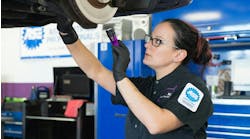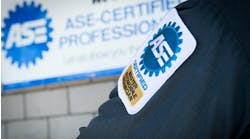Is there really a technician shortage? Or is there a shortage of qualified applicants? Those are two different things.
Right now, there are over 2,000 ASE accredited auto, truck, and collision repair training programs at the high school and college levels with over 125,000 students enrolled in the current school year. We have plenty of “hand-raisers” to work with, but what are we doing to get them into the industry and keep them there?
The bulk of those students are in automotive training programs, but don’t let that hold you back. Surveys show that 18% of students taking auto tech want to work on trucks or heavy equipment. There just isn’t a truck program in their community. For example, Cypress Fairbanks is the third-largest school district in Texas, with 12 high school programs and 1,300 students taking auto tech right now. A local heavy equipment dealer has been growing their workforce from these programs for nearly two decades, even though they don’t work on cars. We need to take the blinders off. Instead of going to a diesel school to look for diesel students, we should be looking at students in all the different transportation training programs.
In the meantime, the industry can do more than merely widen their hiring scope at vocational schools. Whether you’re a large or small fleet, truck dealership, or independent shop, many of these students are not aware of the career opportunities in your company or the truck market in general. It is your responsibility to engage with the programs and students in your community on an ongoing basis. Growing your workforce from the communities you serve is a better long-term strategy than recruiting techs from other shops who may bring their bad habits with them and leave for a dollar an hour more.
Read more: Tips on how shops can help auto/diesel schoolsDoing this by getting involved with schools is key to growing your future workforce. Having someone from your company serve on the advisory committee of the local program is a great start. If you employ someone who went to that school, ask them to volunteer as a guest speaker or have the students and instructors tour your company. These are just a few ideas; the ASE Education Foundation can provide numerous options for getting involved through their free Adopt-A-School program as well.
Once we recruit students to come work for us, the second challenge is keeping them. Past surveys have shown that on average, we lose 41% of these students early on: 20% at graduation and another 21% in the next two years. How can we improve our retention?
Start by asking yourself some hard questions about the work environment in your business. Would you want your children or grandchildren to work in your shop? If not, why would anyone else? What is your turnover rate? Is it higher than you want it to be? If so, what are you doing to fix it? Do you really know why people are leaving your organization or do you believe it is just about money? (Hint: It’s not.)
When someone leaves your organization, they are saying “The unknown is better than staying with you.” Like the maintenance and diagnostics of the vehicles you service, you need to determine and fix the root cause, and stop just replacing people a.k.a. “eating our young.”
You should also check your expectations of newly graduated entry-level techs. Have you ever heard someone say, “I hired this kid out of that high-power tech school and he/she rolled in their new red toolbox, and I put him/her on a job first thing, and they messed it up”? Did the student mess it up, or were they taught a different procedure in school? Or do you shortcut the procedure to get the job finished sooner? Was there someone to mentor him/her on how you do things in your shop, or were they left to figure it out on their own? Many of those new hires have never spent time in a real production environment. They need patience and guidance to grow into the technicians they want to be. The best tool for achieving that is having a seasoned tech serve as a mentor to those young technicians.
A formal mentoring program assists in developing entry-level talent, and even those starting at your company with previous experience. Invest the time and resources to grow your workforce the right way and avoid wasting all the time and energy it took to create the hire.
Read more: How mentorship programs can help combat the technician shortageHowever, be aware that not every great technician makes a great mentor. Careful selection and training of your mentors is important to on-boarding new hires and integrating them into the culture of your shop. When selecting technicians to be mentors, we suggest that you look for those already involved with youth activities (church/temple or youth sports, etc.), have been in the industry about four to six years, and have worked for you at least one year. Then ask them these two key questions: 1) Do you like working in this industry? and 2) Do you like working for our company? Don’t pair new hires with techs that aren’t enthusiastic about both their career and their work with your business.
Finally, treat those mentor technicians like the assets they are. Develop a pay plan that ensures that mentors aren’t negatively impacted for helping grow your workforce and be sure to recognize them among their peers.
By extension, simply showing your employees a little appreciation can go a long way. Whether that means celebrating their accomplishments or making yourself available to them when they need tools or are experiencing difficulties in their personal lives, you need to ask yourself a critical question about your working relationship between yourself and your techs: Do you survey your employees to understand what’s important to them and what they think about you? Do you then honor those results?
Growing your workforce isn’t easy, but you need to recognize it as an investment and not an expense. And remember that the business repairs vehicles, but it runs on people. Treat them right and ensure that your shop is a positive and encouraging environment where people want to come to work.




